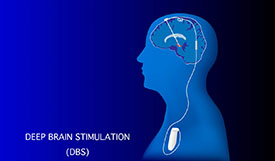Office of Research & Development |
 |
January 14, 2022

Photo: ©Getty Images
Deep Brain Stimulation (DBS) is a surgical procedure used to treat a variety of disabling neurological symptoms, especially those related to Parkinson’s disease (PD). In 2009, seven years after the procedure was approved by the Food and Drug Administration for the treatment of advanced PD symptoms, VA and the National Institutes of Health (NIH) completed the first large-scale analysis of the results of DBS (VA Cooperative Study Program #468).
The researchers concluded that while DBS appeared to be riskier than drug therapy, it could hold significant benefits for those with PD who no longer responded well to medication alone. Today, in a discussion of the procedure on its website, the American Association of Neurological Surgeons provides links to two articles published by the study team, and its recommendations are in accord with the team’s findings.
The research team found that patients who underwent the procedure had better control of their limbs and could walk better than those using medication alone to control their symptoms. They also learned that older patients, who had previously been excluded from brain stimulation research and treatment, benefited from DBS as much as younger people.
Potential side effects from DBS, the team observed, included a decrease in neurocognitive functioning and increases in the rate of infections, falls, depression, gait and balance problems, and pain. These side effects from the procedure were more likely to occur than side effects from medication. DBS also did not help other symptoms of PD, including depression; a decline in mental ability; and trouble with gastrointestinal, urinary, or sexual functions. VA and NIH’s work has helped clinicians throughout the world decide whether or not to recommend DBS to their patients.
Follow-up study tracks survival
In a follow-up study, published in 2017, VA researchers found that patients who received DBS survived an average of 6.3 years after their surgery, compared to 5.7 years for non-DBS patients based on their match to a surgery patient—a difference of eight months. The average age of the Veterans in the study was 69 years.
PD is a disorder of the central nervous system, characterized by the death of dopamine-producing cells in the brain. The disease causes a variety of "motor" symptoms (symptoms related to movement of the muscles), including rigidity, delayed movement, poor balance, and tremors. Non-motor symptoms of PD include sleep disturbances, urinary dysfunction, constipation, swallowing problems, mood disorders, and cognitive deficits. The exact cause of PD is unknown.
DBS uses a surgically implanted, battery-operated device called a neurostimulator to deliver electrical stimulation to targeted areas in the brain that control movement, blocking abnormal nerve signals that cause tremors and other symptoms.
Today, VA researchers are studying how patients perceive the environment in which they walk; how they perceive their motion through an environment, and how they navigate any given environment. These studies are using DBS in hopes of answering questions about how PD patients walk, including how they veer to the side, why they occasionally freeze, and how DBS affects eye movement.
Selected publications:
Randomized trial of deep brain stimulation for Parkinson disease: thirty-six-month outcomes. Weaver FM, Follett KA, Stern M, Luo P, Harris CL, Hur K Marks Jr WJ et al. Neurology. 2012 Jul 3;79(1):55-65.
Pallidal versus subthalamic deep-brain stimulation for Parkinson’s disease. Follett KA, Weaver FM, Stern M, Hur K, Harris CL, Luo PMarks Jr WJ et al. N Engl J Med. 2010 Jun 3;362(22):2077-91.
Survival in patients with Parkinson’s disease after deep brain stimulation or medical management. Weaver FM, Stroupe KT, Smith B, Gonzalez B, Huo Z, Cao L, Ippolito D, Follett KA. Mov Disord. 2017 Dec; 32(12):1756-1763.
Bilateral deep brain stimulation vs best medical therapy for patients with advanced Parkinson disease: a randomized controlled trial. Weaver FM, Follett K, Stern M, Hur K, Harris C, Marks Jr WJ, Rothlind J et al. JAMA. 2009 Jan 7;301(1):63-73.
Parkinson’s Disease Research, Education and Clinical Centers, Department of Veterans Affairs website.
Brain stimulation for Parkinson’s offers improvements in symptoms over three years, VA News Release, June 21, 2012.
Gaining insight into Parkinson’s: Cleveland FES Center using deep brain stimulation to study gait, balance impairment. VA Research Currents, Aug. 28, 2019.